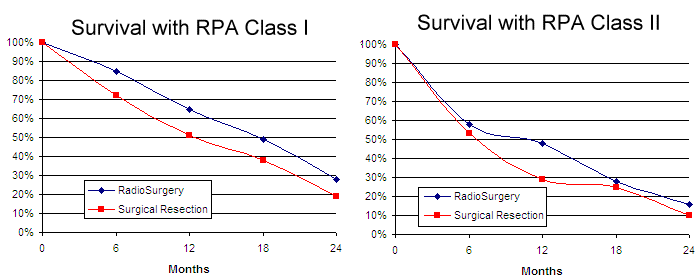|
Stereotactic
radiosurgery alone versus resection plus whole-brain
radiotherapy for 1 or 2 brain metastases in recursive
partitioning analysis class 1 and 2 patients
The objective of this study was to
compare stereotactic radiosurgery (SRS) alone with resection plus
whole-brain radiotherapy (WBRT) for the treatment of patients in
recursive partitioning analysis (RPA) class 1 and 2 who had 1 or 2
brain metastases. Two hundred six patients in RPA class 1 and 2 who
had 1 or 2 brain metastases were analyzed retrospectively. Patients
in Group A (n = 94) received from 18 grays (Gy) to 25 Gy SRS, and
patients in Group B (n = 112) underwent resection of their
metastases and received 10 × 3 Gy/20 × 2 Gy WBRT. Eight other
potential prognostic factors were evaluated regarding overall
survival (OS), brain control (BC), and local control (LC) of treated
metastases: age, sex, performance status, tumor type, number of
brain metastases, extracranial metastases, RPA class, and interval
from tumor diagnosis to treatment of brain metastases. A comparison of the 2 treatment
groups did not reveal significantly different OS (P = .19), BC (P =
.52), or LC (P = .25). In RPA subgroup analyses, outcome also did
not differ significantly for either RPA class of patients. On
multivariate analysis, improved OS was associated with age
SRS alone appeared to be as effective as resection plus WBRT in the treatment of 1 or 2 brain metastases for patients in RPA class 1 and 2. Patient outcomes were associated with age, Karnofsky performance status, number of brain metastases, extracranial metastases, RPA class, and interval from tumor diagnosis to treatment. |
|
|
 60
years (relative risk [RR], 1.75), better performance status (RR,
1.67), no extracranial metastases (RR, 2.84), interval from tumor
diagnosis to treatment >12 months (RR, 1.70, and RPA class 1 (RR,
1.51). Improved BC was associated with a single metastasis (RR,
1.54) and an interval from tumor diagnosis to treatment >12 months
(RR, 1.58), and improved LC was associated with an interval from
tumor diagnosis to treatment >12 months (RR, 1.59).
60
years (relative risk [RR], 1.75), better performance status (RR,
1.67), no extracranial metastases (RR, 2.84), interval from tumor
diagnosis to treatment >12 months (RR, 1.70, and RPA class 1 (RR,
1.51). Improved BC was associated with a single metastasis (RR,
1.54) and an interval from tumor diagnosis to treatment >12 months
(RR, 1.58), and improved LC was associated with an interval from
tumor diagnosis to treatment >12 months (RR, 1.59).